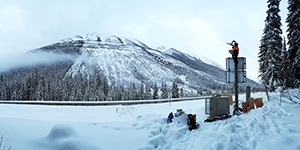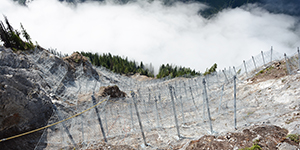By Jaime Sanderson & Naginder Jabbal, McElhanney
 The Trans-Canada Highway (TCH) slices through a densely concentrated cluster of 135 avalanche paths in Rogers Pass, BC. Beginning in April 2015, McElhanney Ltd and Dynamic Avalanche Consulting, with client Parks Canada Agency’s (PCA) oversight, developed and implemented an Avalanche Mitigation program that uses innovative solutions to mitigate risk to highway users, reduce highway closure times, and improve overall efficiency.
The Trans-Canada Highway (TCH) slices through a densely concentrated cluster of 135 avalanche paths in Rogers Pass, BC. Beginning in April 2015, McElhanney Ltd and Dynamic Avalanche Consulting, with client Parks Canada Agency’s (PCA) oversight, developed and implemented an Avalanche Mitigation program that uses innovative solutions to mitigate risk to highway users, reduce highway closure times, and improve overall efficiency.
About $2.7M of highway freight passes through this corridor each hour – making every minute of highway closure saved by the avalanche mitigation program a considerable economic benefit.
The work was completed largely in remote areas (challenging site access, steep terrain) with high winds and extreme temperatures (well below -30°C, rime ice). As no detailed topographic information existed for this area, engineers relied on LiDAR expertise and field reconnaissance.
As a result of the below solutions, program analysis shows a 17% forecasted reduction in highway closure time and a 27% anticipated reduction in the Avalanche Hazard Index.
The team managed the install of 13 RACS, which use explosives to initiate avalanches in five key paths. This system uses biodegradable explosives to release avalanches at optimum times and reduces the need for active control. RACS are powered sustainably through green sources like methanol fuel cells and solar panels.
 |
 |
 |
About 2km of snow nets mitigate avalanches in three critical avalanche paths. With no existing North American guidelines to use, the project team utilized Swiss guidelines as a base. The netting prevents snow in the start zone from releasing - stopping avalanches from developing.
The biggest of its kind, the ADN is a network of 13 overlapping infrasound arrays and four Doppler radar systems that generates real-time avalanche detection alerts. This data helps PCA’s avalanche forecasters make vital highway closure decisions.
An 80m long and 20m high reinforced earthen berm was designed to reduce the likelihood of glide slab avalanches from reaching the TCH and blocking the snowshed portal. Up to 200,000m³ of local materials (such as landslide debris) was used as fill materials for additional traffic staging (ponding) areas, as well as the berm.
These projects were completed on a scale and complexity not seen before in North America – setting a new benchmark (regularly raised based on lessons learned and technology developments) for what can be done to secure the safety and reliability of our highways. While much of the heavy lifting and innovation was undertaken in the first five years, it will be many decades for full program implementation.